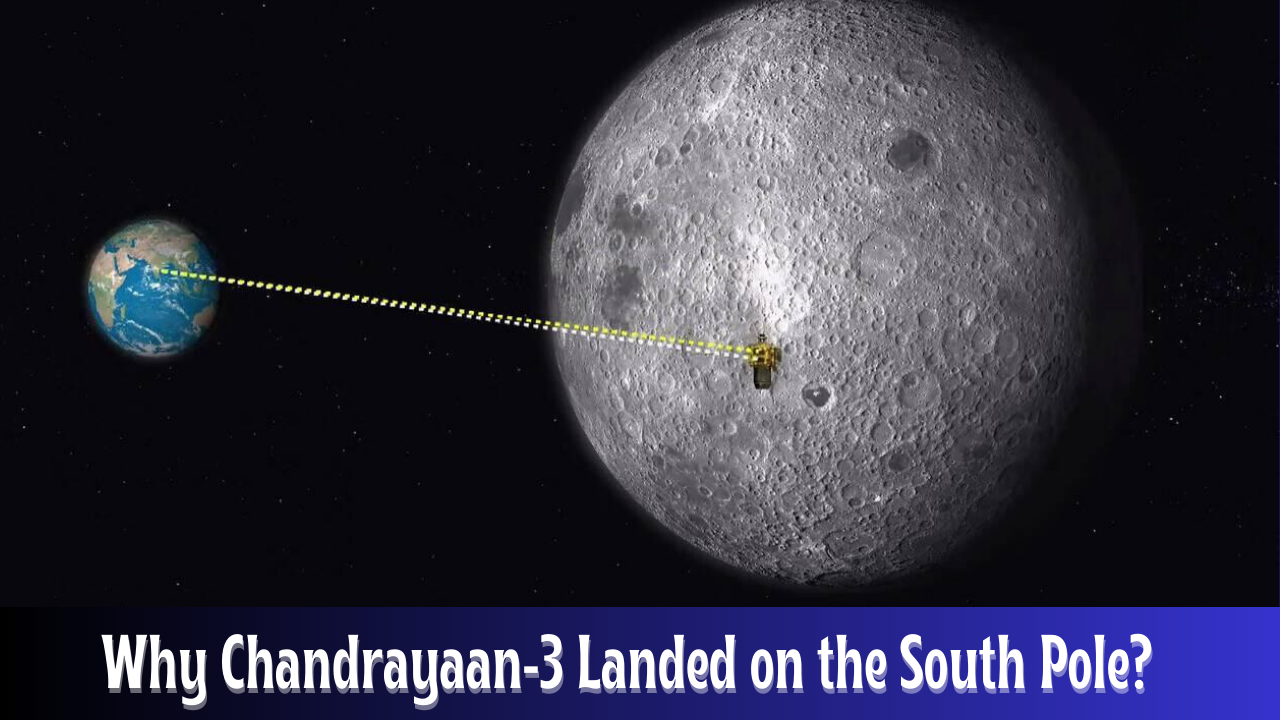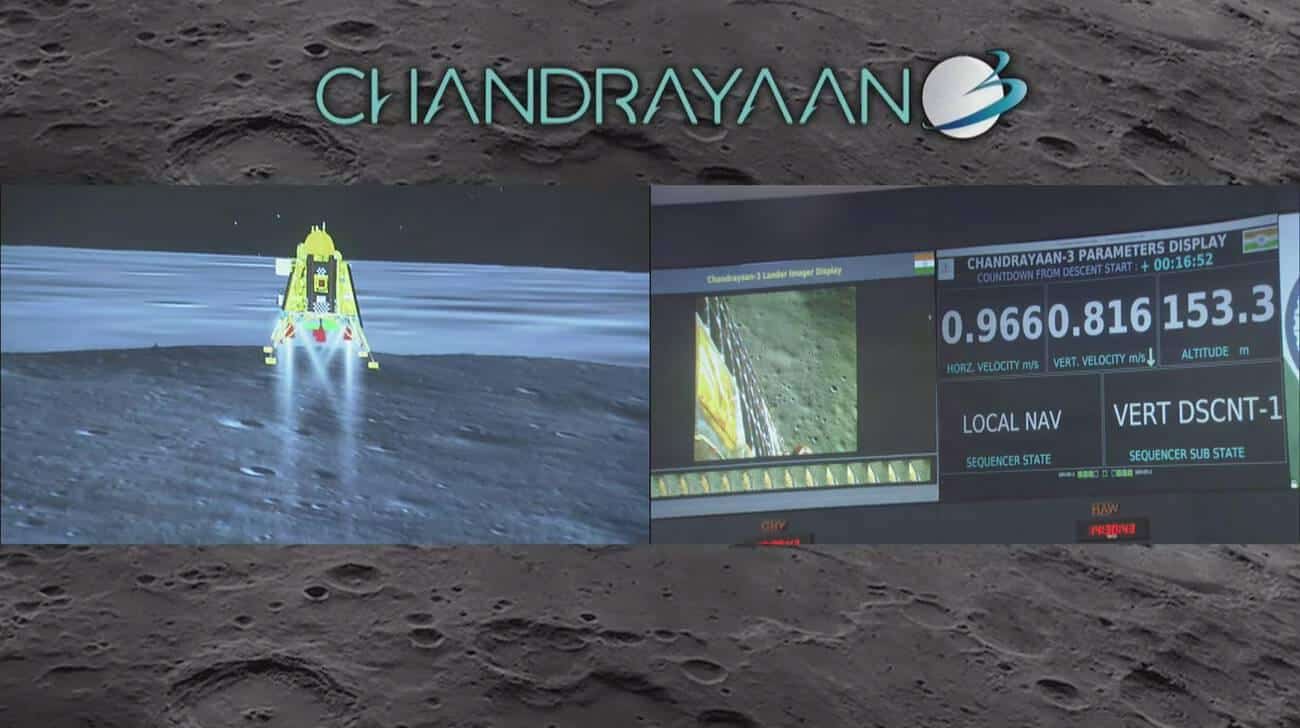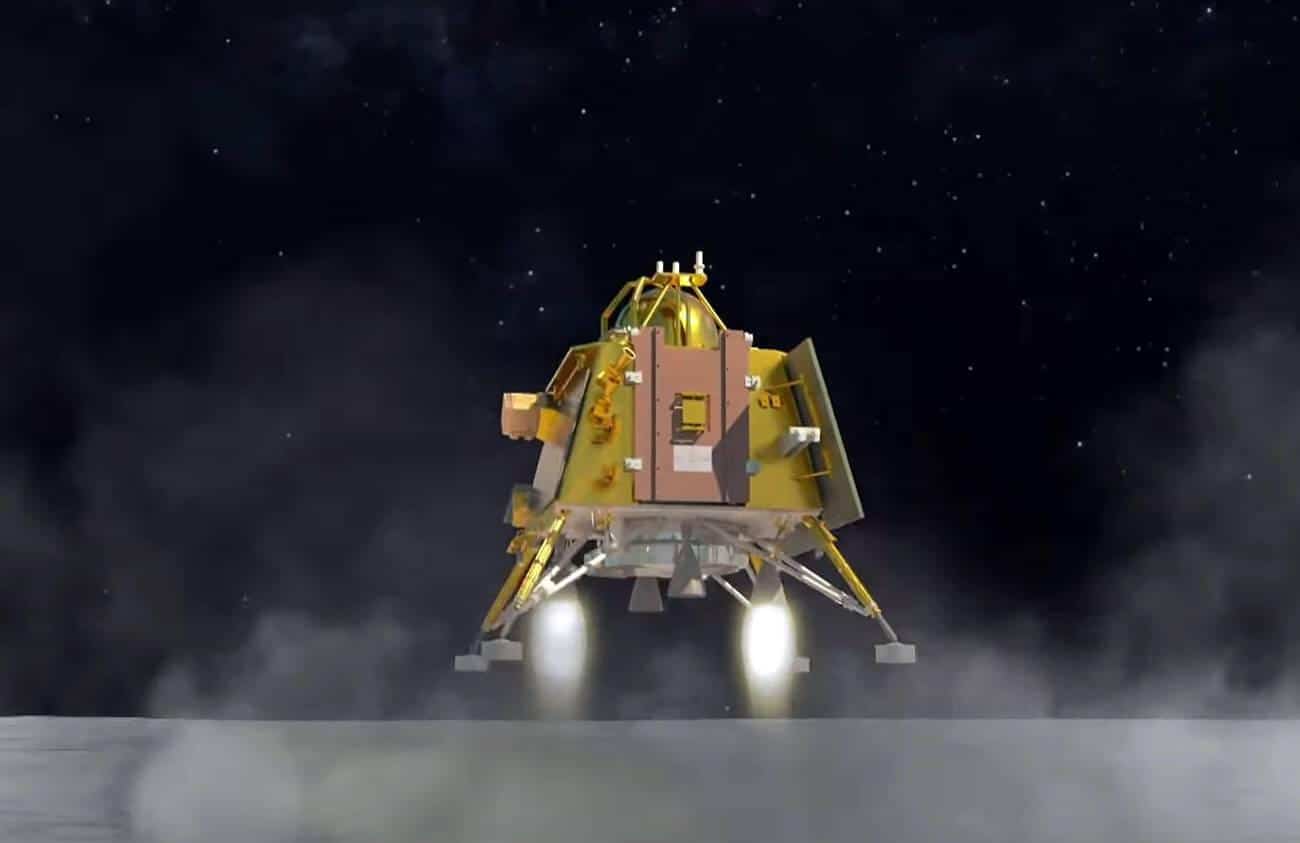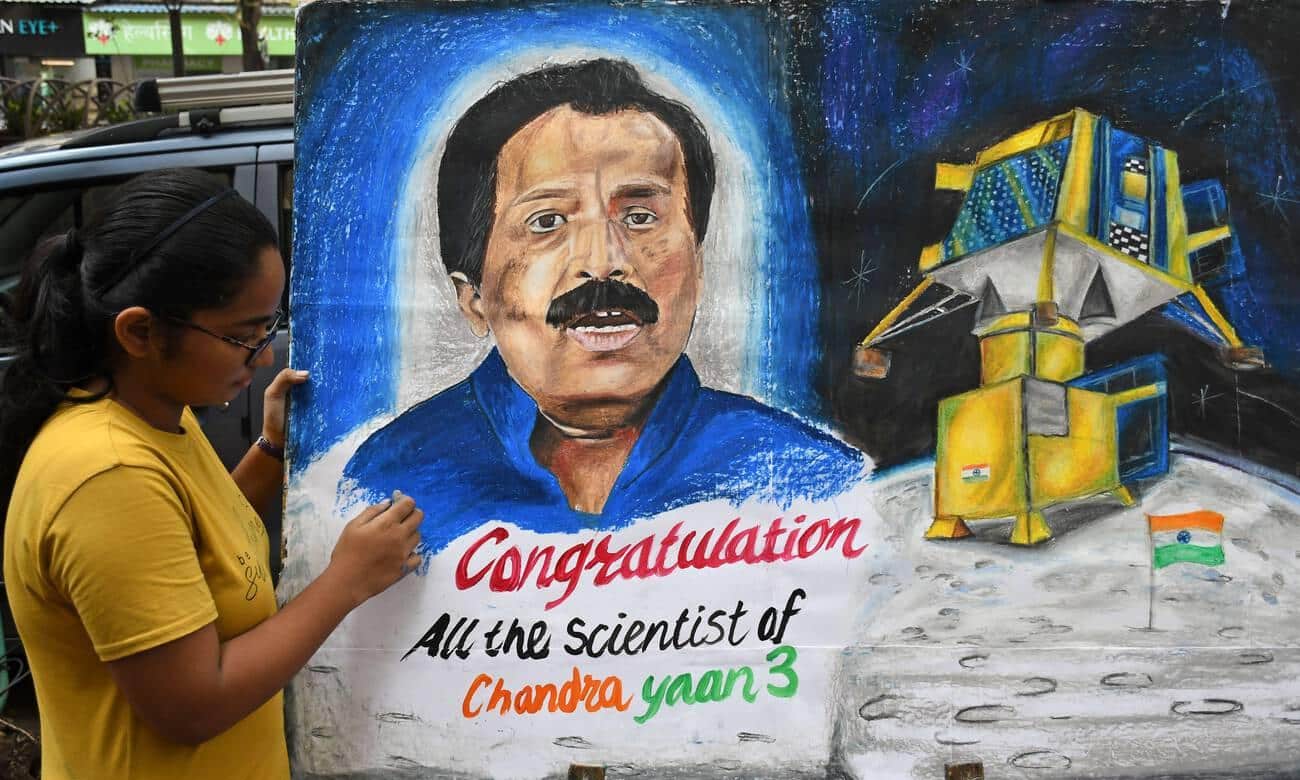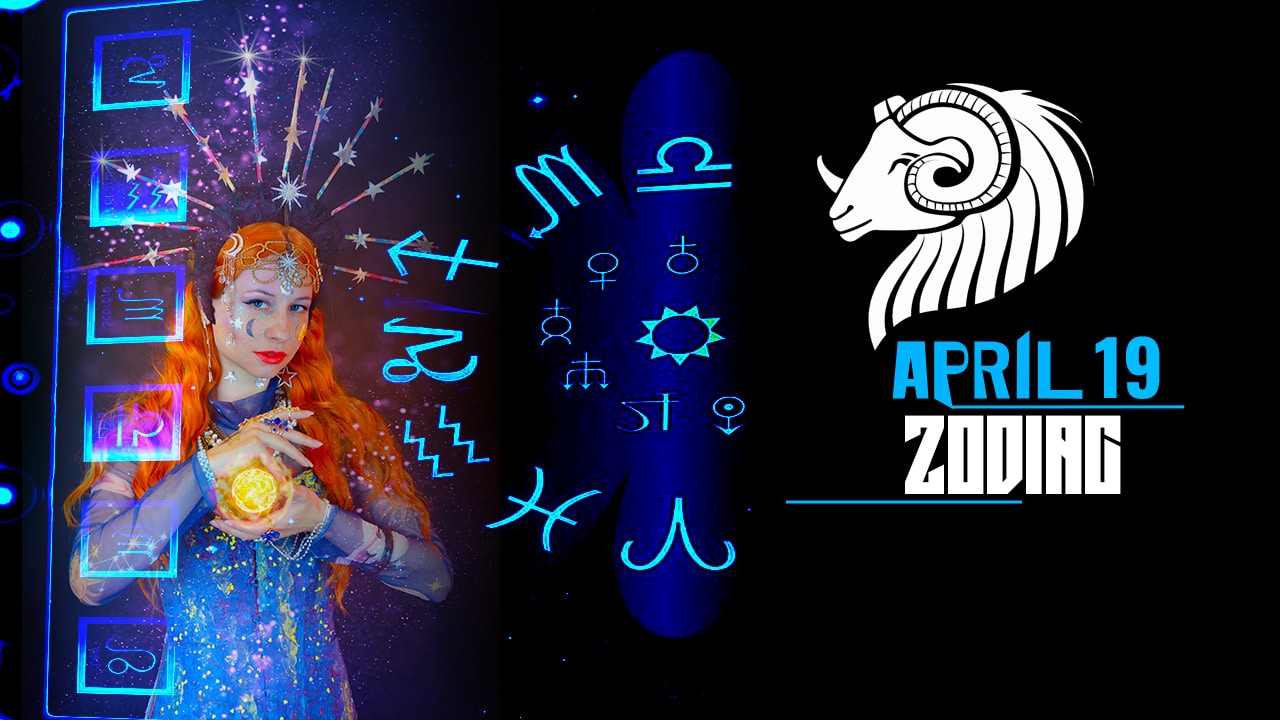The moon’s South Pole has always been shrouded in mystery, arousing curiosity and intrigue. Did you know that ISRO’s Chandrayaan-3 is geared to explore this enigmatic region?
This blog delves into why Chandrayaan 3 landed on south pole of the moon, shedding light on its hidden treasures and underlying scientific importance.
Dive deeper into the astonishing world of lunar exploration with us!
Content Highlights
- Chandrayaan-3 – 3 was launched to explore the moon’s South Pole, an uncharted area no one has ever been to.
- The mission aims to find frozen water on the moon, as it could be a valuable resource for future space missions and potentially even sustain human presence on the moon.
- Landing in the South Pole presents challenges due to unique topography, limited sunlight, and extreme temperatures, but it also offers opportunities for important scientific discoveries about lunar geology.
Why Chandrayaan 3 Landed on South Pole?
Exploring uncharted territory offers opportunities to discover potential water resources and gain a deeper understanding of lunar geology.
Here are some of the reasons why the South Pole is a good place to look for water ice:
- The South Pole is constantly in shadow, so the temperature is much colder than the rest of the Moon. This makes it more likely that water ice will be preserved.
- The south pole is covered in craters, which provide shelter from the harsh solar radiation. This is important because water ice can be easily broken down by radiation.
- The south pole is near the lunar equator, which receives more sunlight than other parts of the Moon. This is important because sunlight is needed to power solar panels and other equipment.
Exploration of uncharted territory
The South Pole of the Moon is an uncharted area. No one has ever been there before. Chandrayaan-3 will be the first to go. It’s a big deal for science and space study. This part of the moon could hold special things inside it.
The goal is to learn what lies hidden in this new place on our nearest neighbor in space, with no idea what might be found.
Potential for water resources
The South Pole of the moon holds a lot of water. Chandrayaan 3’s goal is to find this frozen water. Water on the moon can give us oxygen, fuel, and even drinking water for future trips to space.
Finding this ice also means we could live on the moon. The South Pole has enough ice for life to stay there for a long time. This gives India and ISRO big plans for future space missions and bases.
Possible signs of life
The South Pole is also a good place to search for signs of past or present life on the Moon. The cold temperatures and lack of sunlight at the South Pole could have helped to preserve any evidence of life.
Understanding lunar geology
The moon’s rock and dirt tell a lot about it. The south pole of the moon has special rocks and land shapes. ISRO uses Chandrayaan 3 to study these. This helps us know how the moon changed over time.
We also learn what materials are on the moon’s south pole. Some of these might be useful in the future for space missions!
Technological challenges
Landing on the Moon’s south pole is a challenging task, which will require the use of advanced technologies. Chandrayaan 3 will help to test and develop these technologies, which could be used for future missions to the Moon and other planets.
Discovering Water on the Moon
Scientists have made the groundbreaking discovery of water on the Moon, marking a significant milestone in lunar exploration.
How scientists found water
Scientists found water on the moon through the Chandrayaan-1 mission in 2008. They used a NASA instrument onboard the spacecraft to detect water molecules on the moon’s surface. Data collected from Chandrayaan-1 confirmed the presence of water ice on the moon’s south pole.
Significance of water on the Moon
Water on the Moon is a big deal. Scientists have found water ice on the south pole of the Moon, and this discovery has important implications for future space exploration. The presence of water means that there could be resources to sustain human presence on the Moon, like fuel, oxygen, and drinking water.
This challenges what we thought we knew about the Moon’s composition. So confirming the presence of water ice in this region with missions like Chandrayaan-3 is crucial for our understanding and plans for lunar exploration.
Related Read: The Battle for the Lunar South Pole
Challenges of Landing on the Moon’s South Pole
The unique topography, limited sunlight, and extreme temperatures pose significant challenges for landing on the Moon’s South Pole.
| Attribute | Value |
|---|---|
| Launch date | July 14, 2023 |
| Launch vehicle | Geosynchronous Satellite Launch Vehicle Mark III (GSLV Mk III) |
| Launch site | Satish Dhawan Space Centre, Sriharikota |
| Orbit | Lunar orbit |
| Landing site | South Pole |
| Lander | Vikram lander |
| Rover | Pragyan rover |
| Instruments | 8 payloads |
| Status | Successful landing on the Moon’s south pole on August 23, 2023 |
Chandrayaan-3 Lunar Mission Overview Table
Here are some of the payloads on Chandrayaan 3:
- Radio Anatomy of Moon Bound Hypersensitive Ionosphere and Atmosphere (RAMBHA): This instrument will study the Moon’s ionosphere and atmosphere.
- Chandras’ Surface Thermo Physical Experiment (ChaSTE): This instrument will study the Moon’s surface temperature and composition.
- Instrument for Lunar Seismic Activity (ILSA): This instrument will study the Moon’s seismic activity.
- Laser Retroreflector Array (LRA): This instrument will track the Moon’s motion.
- Alpha Particle X-Ray Spectrometer (APXS): This instrument will analyze the Moon’s surface composition.
- Laser-Induced Breakdown Spectroscope (LIBS): This instrument will analyze the Moon’s surface composition.
Unique topography
The south pole of the Moon has a special kind of landscape that makes it different from other areas. It is covered in craters and has rough terrain. This can make it challenging for spacecraft to land safely.
The surface is also very cold, with extremely low temperatures. These unique features of the lunar south pole make it an interesting and important place to explore.
Limited sunlight and extreme temperatures
The Moon’s South Pole presents a unique challenge for landing missions due to limited sunlight and extreme temperatures. In these regions, the lack of sunlight and low temperatures make it difficult for instruments to operate effectively.
The craters at the south pole create permanent shadow areas where sunlight rarely reaches, making it even more challenging. Additionally, temperatures can plummet to very cold levels during the long lunar night.
These factors pose significant obstacles that must be overcome by space agencies like ISRO when planning missions like Chandrayaan-3.
India’s Chandrayaan-3 Mission Objectives
India’s Chandrayaan-3 mission aims to land on the Moon’s South Pole, collect data on the lunar surface, and establish a lunar base.
Landing on the Moon’s South Pole
Chandrayaan-3 successfully landed near the Moon’s south pole, showcasing India’s growing space prowess. The mission objective was to explore and gather data from this unexplored region of the Moon.
Landing on the Moon’s south pole is important because it allows us to explore new territory and understand lunar geology better. It also has potential water resources that scientists are interested in studying.
However, there are challenges to landing in this area, such as unique topography and limited sunlight with extreme temperatures. Nonetheless, Chandrayaan-3’s successful landing marks a significant achievement for India’s space program and contributes to global efforts in lunar exploration.
Collecting data on the lunar surface
Chandrayaan-3’s main objective is to collect data on the lunar surface, specifically at the moon’s south pole. This region is of great interest to scientists because it is believed to contain water ice.
By studying this area in detail, we can learn more about the presence and characteristics of water on the Moon. Gathering data about the lunar surface will help researchers better understand its geology and composition, which can provide valuable insights into the formation and evolution of our closest celestial neighbor.
Chandrayaan-3’s mission aims to gather vital information that will contribute to our understanding of the Moon and pave the way for future exploration and scientific discoveries.
You May Find Interest: Google’s Animated Doodle Celebrates India’s Soft Landing on the Moon
Establishing a lunar base
The Chandrayaan-3 mission has a crucial objective: to establish a lunar base. Landing near the moon’s south pole is pivotal for this endeavor. By collecting data and conducting experiments, scientists hope to gather valuable information that will contribute to potential human settlements on the moon.
This lunar base could serve as a stepping stone for further space missions and solar system exploration. The successful landing near the moon’s south pole opens up new possibilities for advancements in understanding the moon’s geology and potential for future human missions.
ISRO’s Progress as a Space Power
ISRO has made significant advancements in space technology and has successfully launched previous lunar missions, making it a key player in the global race to explore the Moon’s South Pole.
Learn more about India’s ambitious plans for Chandrayaan-3 and its future as a space power.
India’s previous lunar missions
India’s previous lunar missions:
- In 2008, India launched its first lunar mission called Chandrayaan – 1.
- Chandrayaan-1 – 1 successfully orbited the moon and made significant discoveries, including evidence of water molecules on the lunar surface.
- The mission also revealed new information about the moon’s topography and mineral composition.
- In 2019, India attempted to land a spacecraft near the moon’s south pole with Chandrayaan – 2.
- Unfortunately, the landing was unsuccessful, but it was still considered a major achievement in reaching the intended target.
- Despite the setback, India’s space program has made significant progress.
Advancements in space technology
Advancements in space technology:
- Development of more efficient and powerful rocket engines
- Miniaturization of spacecraft components for better efficiency and cost-effectiveness
- Improvement in navigation and communication systems for better accuracy and real-time data transmission
- Innovations in materials and construction techniques to make spacecraft more durable and lightweight
- Use of artificial intelligence and robotics for autonomous operations in space
- Integration of advanced sensors and instruments for precise data collection
- Enhancement in imaging and remote sensing capabilities for detailed exploration of celestial bodies
- Progress in propulsion systems, including ion propulsion, for longer missions and increased maneuverability.
Global Race to the Moon’s South Pole
Countries worldwide are competing to explore the Moon’s South Pole and discover its untapped resources – find out why it’s an exciting race!
Competition among countries
Many countries, including India and Russia, are racing to land on the moon’s south pole. Before India’s Chandrayaan-3 mission, only the Soviet Union, the United States, and China had achieved soft landings on the moon.
This highlights the intense competition in lunar exploration between nations. Russia was also vying to be the first nation to land at the lunar south pole with its Luna-25 mission.
This global race signifies a new era of exploration involving various countries, such as the US and Israel, all striving for scientific discoveries and advancements in space technology.
Discovery of resources
The discovery of water ice on the Moon’s south pole has sparked a lot of excitement and interest in space exploration. Scientists have found traces of water, a valuable resource, as it can be used for future missions to the Moon or beyond.
This discovery has opened up possibilities for sustaining life and supporting human colonization on other celestial bodies. It has also highlighted the importance of further exploration and research to uncover more resources that may exist on the Moon and other planets in our solar system.
Potential Benefits of Lunar Exploration
Lunar exploration opens up endless avenues for scientific research and advancements in space exploration. Discover more about the potential benefits of exploring the moon in our blog!
Scientific research possibilities
Exploring the lunar south pole offers exciting scientific research possibilities. By studying this uncharted territory, scientists can learn more about the moon’s geology and gain valuable insights into its formation.
The discovery of water ice in this region is particularly significant as it opens up resource extraction and utilization opportunities. This could be crucial for future space missions, enabling us to produce oxygen, fuel, and even water on the moon.
Understanding these scientific possibilities can help advance our knowledge of space exploration and pave the way for further discoveries in the future.
Space exploration advancements
Space exploration has always driven advancements in science and technology. With missions like Chandrayaan-3, countries like India are pushing the boundaries of what we know about space.
Scientists hope to uncover valuable discoveries and gain insights into our universe by studying the moon’s south pole. These advancements contribute to our understanding of space and have practical applications here on Earth.
For example, new technologies developed for space exploration can be used in various industries, such as medicine and telecommunications. The discoveries made through missions like Chandrayaan-3 will undoubtedly lead to even more exciting developments in space exploration.
Future of India’s Space Program
India’s space program is set to soar even higher, with plans for future missions and ambitious goals. From exploring other celestial bodies to collaborating with international partners, India is on a trajectory towards becoming a key player in the global space industry.
Read on to discover the exciting possibilities for India’s space program.
Planned missions and goals
India’s space program has several planned missions and goals for the future. These include:
- Gaganyaan Mission: India plans to send three astronauts to space through the Gaganyaan mission. This will be India’s first manned mission and a significant achievement.
- Chandrayaan-4: After the success of Chandrayaan-3, India aims to launch Chandrayaan-4, another lunar mission. This mission will further explore uncharted territories on the moon and gather more data about its surface.
- Aditya-L1 Mission: The Indian Space Research Organization (ISRO) is also working on the Aditya-L1 mission, which aims to study the Sun from space. This mission will help scientists understand solar dynamics and its effects on Earth’s climate.
- Small Satellite Missions: ISRO plans to launch several small satellite missions in the coming years. These missions will focus on various aspects, such as communication, navigation, and remote sensing.
- International Collaboration: India’s space program actively seeks collaborations with other countries and international space agencies. This includes joint ventures for research, technology development, and exploration missions.
Collaboration with other countries
India’s Chandrayaan-3 mission involved working together with other nations in the field of space exploration. This collaboration is crucial because it allows for knowledge sharing and technological advancements.
By partnering with other countries, India can access additional resources, expertise, and funding, making space missions more feasible and efficient. Furthermore, collaborating with other nations fosters diplomatic relations and promotes international cooperation in scientific endeavors.
The success of this mission demonstrates the significance of working together to achieve major milestones in space exploration.
Frequently Asked Questions (FAQs)
To know more about the Chandrayaan-3 lunar mission, check the answers below.
1. What is Chandrayaan 3?
Chandrayaan 3 is a space mission from India.
2. Why was Chandrayaan 3 launched in the South Pole?
We don’t know for sure why they chose the South Pole. But it could be because they wanted to look for water or study something else there.
3. Did someone go with Chandrayaan 3 to the South Pole?
Chandrayaan 3 went by itself on its trip to the South Pole; no human went with it.
4. Is this India’s first time sending something like this to the South Pole?
No, this isn’t their first time doing this sort of thing at all! They have done similar things before with other missions, too.


